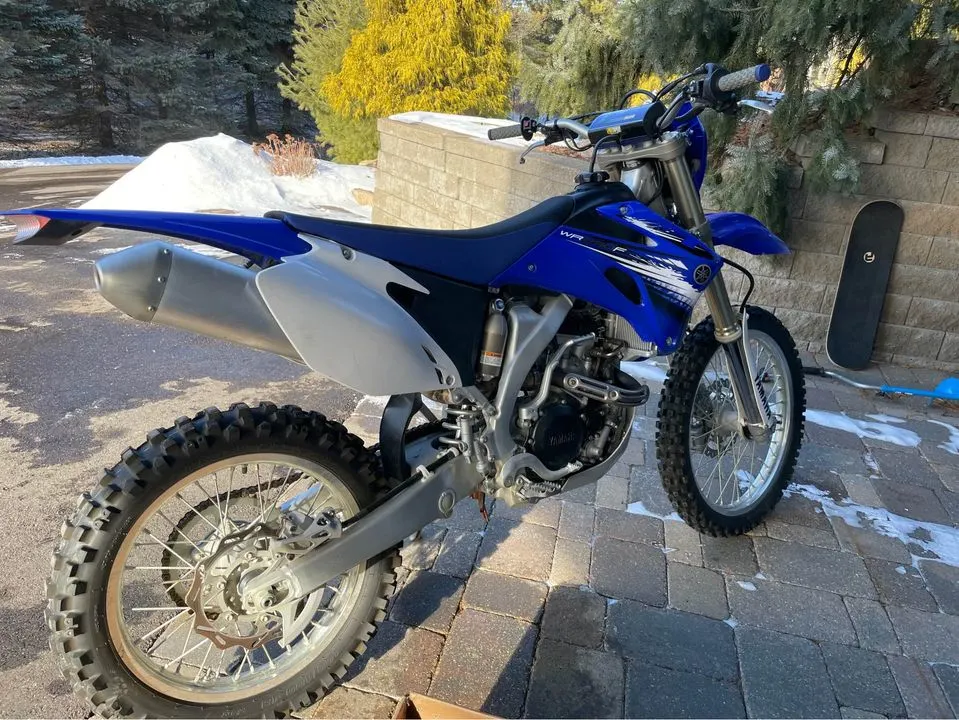Looking for the best 250cc Yamaha enduro bike but not sure which one is best? Whether you're a beginner, upgrading your trail bike, or want to race with one, you've found the right article!
In this WR250F vs YZ250FX vs YZ250F comparison, I will break down the differences between these three 250cc 4-stroke Yamaha dirt bikes, why each one may or may not be right for you, how how to choose the best dirt bike based on your specific needs.
What’s the difference between WR250F and YZ250FX?
While they’re both 250 enduro bikes, the main difference is that the YZ250FX is a more aggressive enduro bike with a snappier power curve and stiffer suspension, while the WR250F has a softer suspension and a slightly smoother powerband.
However, it depends on what model year Yamaha WR250F you’re looking at. They have changed quite a bit over the years since it was first made in 2001.
![2016 Yamaha WR250F WR250F vs YZ250FX vs YZ250F Differences [Which To AVOID?]](https://motocrosshideout.com/wp-content/uploads/2022/08/2016-Yamaha-WR250F.jpg.webp)
Is a WR250F a trail bike or an enduro bike?
I consider the WR250F to be an enduro bike, but it depends on how you categorize off-road motorcycles. For example, it’s a good 4 stroke dirt bike for trail riding, but I also consider a “trail bike” to be an off-road motorcycle that’s simple and low-performance compared to an enduro bike.
A couple of more specific examples would be the engine and suspension. The WR 250F has a modern-style liquid-cooled engine and high-performance forks and rear shock.
It has quite a bit more power (mostly at higher RPM) with a snappier power curve, a taller seat height due to more suspension travel, and stiffer suspension due to being tuned for faster and more aggressive riding.
Is the Yamaha YZ250FX a good trail bike?
The YZ250FX is a good trail bike - if you’re the right rider. You see, a common mistake I hear from my students that go through our courses & programs, as well as our readers, is that they buy too powerful of a dirt bike when they’re a beginner.
They think that they’ll “grow into” the bike so they don’t have to upgrade a year or two later from a “Beginner bike”. But what they’re doing is making it harder to build their confidence because a YZ250FX has a lot of power that will put you on the ground quickly if you don’t have your weight shifted properly and whiskey-throttle by giving it too much gas.
![2019 Yamaha YZ250FX WR250F vs YZ250FX vs YZ250F Differences [Which To AVOID?]](https://motocrosshideout.com/wp-content/uploads/2022/08/2019-Yamaha-YZ250FX.jpg.webp)
So, the YZ 250FX is NOT a good trail bike if you’re a beginner or just casually riding tight and technical trails. It’s better if you’re an aggressive rider or racing that needs more power and stiffer suspension to ride at higher speeds and hit bigger obstacles off-road or on the track.
WR250F vs YZ250F major differences
Depending on which model year you’re comparing, the WR250F and YZ250F share a lot of similarities, but the way is quite a bit different.
The biggest difference is that the WR250F is a trail bike that has softer suspension, smoother power, and more accessories for trail riding that make it more comfortable and functional riding off-road rather than racing on a motocross track.
![2010 Yamaha YZ250F WR250F vs YZ250FX vs YZ250F Differences [Which To AVOID?]](https://motocrosshideout.com/wp-content/uploads/2021/11/2010-Yamaha-YZ250F.jpg.webp)
The WR250F is based on the YZ250F, although some years lagged behind in technological updates. Simply put, Yamaha always updated the YZ250F motocross bike with higher performance parts and technology first. The WR250F either got these updates the following year or several years later.
For more specific details, each section below will cover all of the major differences between the WR250F vs YZ250FX vs YZ250F comparison.
WR vs YZ vs YZFX Engine and power comparison
The YZ250F is a race bike specifically built for motocross, so the engine package makes it snappy and powerful. It has a close-ratio transmission to keep the RPM in the meat of the powerband when you shift gears.
![2015 Yamaha YZ250FX Engine WR250F vs YZ250FX vs YZ250F Differences [Which To AVOID?]](https://motocrosshideout.com/wp-content/uploads/2023/03/2015-Yamaha-YZ250FX-Engine.jpg.webp)
On the other hand, the WR250F engine is slightly detuned and is built for low-end and midrange torque. You're not going to be holding it wide open throttle all the time on the trails, so you don't need that peak horsepower.
More torque down low makes it easier to ride in the woods because it's smoother and more predictable. The heavier flywheel also helps prevent stalling and gives you a little better traction because the extra weight that the engine has to spin won't break the rear tire loose as quickly.
The YZ250FX is tuned very similarly to the YZ motocross bike, so the power is snappy and better for medium to high-speed riding. It has slightly more low-end torque than the YZ, but it's noticeably more twitchy at low RPM compared to the WR.
Exhaust differences
The YZ250F and YZ250FX are closed-course competition exhaust systems. This means that the YZ250FX does NOT have a spark arrestor even though it's made for off-road riding.
The exhaust on the WR is 'corked up' compared to the YZ and YZFX, which is straight-through for best performance (and is much louder). This is to make it quieter and be legal for trail riding with the U.S.F.S approved spark arrestor.

Transmission differences between these 250cc Yamaha enduro bikes
With a wide-ratio transmission (hence "WR"), 1st and 2nd gear are shorter and more usable at low speeds, which is great for tight and technical trails. 4th and 5th gear is also longer, allowing you to ride or cruise at a higher speed at a lower RPM, putting less wear on the engine.
Yamaha added a 6th gear to the WR250F in 2015 when they also added the YZ250FX model, which has the same 6-speed wide-ratio transmission as the WR. The YZ250F has always had a close-ratio 5-speed gearing, which makes it easier to keep it in the meat of the power when shifting for racing.
All of these bikes can gain significant bottom-end torque with a big bore kit while staying reliable if you need more power down low.
WR250F vs YZ250FX vs YZ250F Suspension
One of the biggest differences between these Yamaha dirt bikes is the suspension and how it is set up from the factory.
The YZ 250F is tuned for big impacts to absorb all of the jumps and landings, so the forks and shock have stiffer springs and valving.
The WR 250F needs to be more compliant (plush) for trail riding because the impacts are generally quicker and much smaller. The forks and shocks are quite a bit softer and tuned differently to make it comfortable riding off-road.
The YZ250FX is somewhere in between, which also makes it the best option if you need one dirt bike for riding on the track and the trails. It's stiffer for faster off-road riding, but not as stiff as the YZ motocross bike suspension setup.
Trail Options
While the engine and suspension are the biggest single differences comparing these 250 Yamaha’s, the WR250F has quite a few more options or accessories that make it more comfortable and enjoyable to ride on the trails all day.
Electric start (older models)
If you’re looking at a 2018 and older YZ250F, it only had a kickstart, while the WR250F has always had kick-start since 2003.
Electric start isn’t a necessity, but I’m a big fan of it for trail riding. Dirt bike companies have pretty much figured out how to make them reliable…. Do you crank over your car engine by hand? Electric start is here to stay if you’re a nay-sayer.
Flywheel
It may not seem like a big deal, but the WR250F has a heavier flywheel than the YZ and YZFX engines. This does not change the torque or horsepower, but rather slows down how quickly the engine revs up and slows down…
Wait, what? Why would you want it to rev slower?!
In racing applications, I wouldn’t unless the track is slippery, which brings me to my point. Having a heavier flywheel (at least on this engine) is good for trail riding because the power feels smoother, making it get better traction, and giving you more control.
It’s also less likely to stall because the inertia keeps the engine spinning a little bit longer. Having good clutch control is still very important if you want to be a good trail rider.
Rear tire size
Another slight difference is the rear wheel and tire size. The WR250F and YZ250FX have an 18” rear wheel and tire (as opposed to 19” on the YZ). This allows you to have a bigger sidewall and knobbies for better grip/traction riding on slick or rocky trails.
Lights
This one is a no-brainer - do you need or want lights? Whether you’re going to be registering it for road use or not, having a headlight on the WR250F may help you find your way home or back to camp after getting lost out in the mountains after dark.
Bigger gas tank
One of the reasons why the YZ250F is lighter is because the gas tank is smaller (less fuel also means less weight). But, having a bigger gas tank on the WR 250F and YZ 250FX also means that you can ride longer and further without needing to fill up. If you go on a long ride with a friend on a motocross bike, you might have to lend some gas to make it back to HQ.
Radiator overflow tank
Having your dirt bike overheat can happen on the track or the trails, but it’s most common while riding tight and technical trails. What happens when a liquid-cooled dirt bike gets too hot? Coolant spews out the radiator overflow tube.
This is why the WR250F has an overflow tank that catches the ‘lost’ coolant, and then once it cools down, that extra coolant will get sucked back into the radiator.
If your radiator gets too low on coolant, it will stay hot and overheat more easily.
Which one is best for trail riding?
If you haven’t figured it out already, the WR250F and YZ250FX are clearly the better trail bikes for several reasons. Smoother and more predictable power, softer suspension, and all of the options/accessories that make it more comfortable riding in the woods, bush, or mountain trails.
When comparing the WR250F vs YZ250FX for trail riding, you simply have to ask yourself these two questions:
- How fast will you be riding?
- Do you need lights?
If you're riding at slower speeds and need lights then the WR250F is the better Yamaha 250 for you.
Can you trail ride a YZ250F?
Yes, you can absolutely ride a YZ250F motocross bike on the trails. With that said, I wouldn’t recommend it because of all the reasons listed above: abrupt power, stiff suspension, gearing, and lack of trail accessories.
The tighter and more technical the trail is, the more challenging it will be riding a YZ250F motocross bike on it because its light flywheel and twitchy power at low RPM make it easier to stall.
Which is better for beginners?
No matter what type of riding you plan on doing, if you’re looking for your first dirt bike then you want to pick the one that’s easiest to ride. Why? Because learning to ride a dirt bike requires skill and practice, and it will only make it harder to learn on a dirt bike that’s harder to control.
This is why the WR250F is a better dirt bike for beginners than the YZ250F.
It's better, but NOT the best for beginners
Now with that said, I don’t even recommend getting the WR250F if you’re new to dirt biking because even this bike has more power than you really need (for 99% of beginners). When you have too much power to control, you're more likely to wheelie and end up on the ground more often.
An even better first dirt bike would be the TTR230 trail bike because it’s slightly smaller and the power is much smoother and easier to control. It's also cheaper and easier to maintain.
WR250F vs YZ250F vs YZ250FX breakdown
Just want the bullet-point list of all the differences between the WR vs YZ vs YZFX 250 Yamaha 4-stroke dirt bikes?
WR250F:
- Engine tuned for smoother power (more low/midrange torque & less top end HP)
- Softer suspension for low-speed trail riding
- Wide-ratio transmission (2015+ added 6th gear)
- 18-inch rear wheel
- Kickstand
- Larger gas tank
- Headlight/tail light
- Spark arrestor - quietest muffler (restricts some power)
- Radiator overflow tank
- High output stator for lighting
- Heavier flywheel - smoother throttle response and helped prevent stalling
YZ250FX:
- Engine tuned for aggressive but broad power from low-end to top end
- Stiffer suspension for faster & more aggressive riding
- Wide-ratio transmission (2015+ added 6th gear)
- 18-inch rear wheel
- Kickstand
- Larger gas tank
- No lights
- Loudest exhaust for best performance - no spark arrestor
- Lighter flywheel - quick-revving for racing (15-19 had a heavier flywheel)
YZ250F:
- Engine tuned for aggressive power from mid-top-end HP
- Stiffest suspension for motocross racing with big jumps and obstacles
- Close-ratio 5-speed transmission
- 19-inch rear wheel
- No kickstand
- Smaller gas tank
- No lights
- Loudest exhaust for best performance - no spark arrestor
- Lightest flywheel - quick-revving for racing
How to become a better & safer rider with less seat time
If you’re a beginner and are trying to get started dirt biking but want to stay safe, then I want to help you out. The quickest way to improve your skill while learning how to ride with more control is by learning the proper techniques. I made a practical guide that shows you these basic techniques and I want to give it to you as a gift for free. Click here to learn more.

